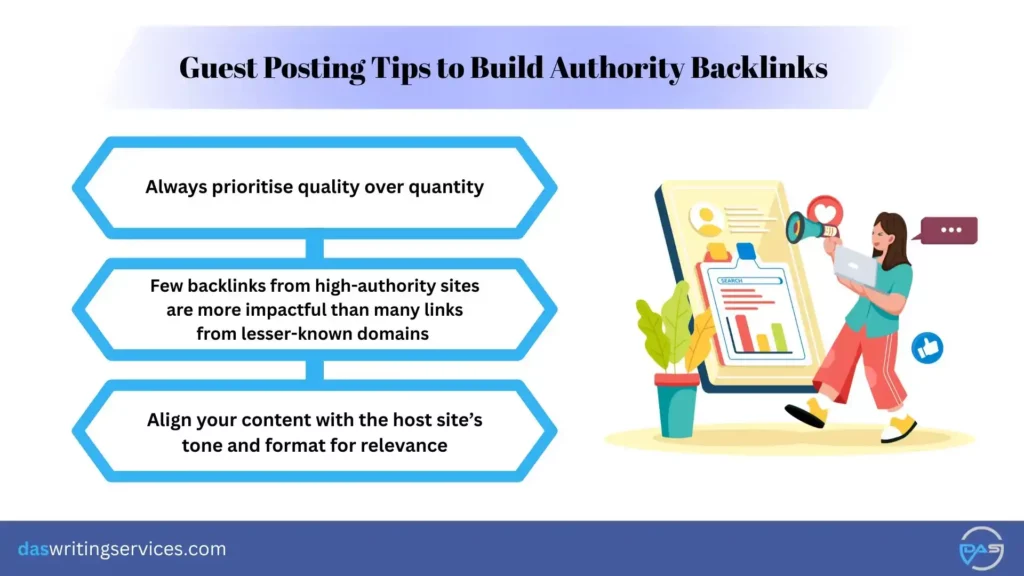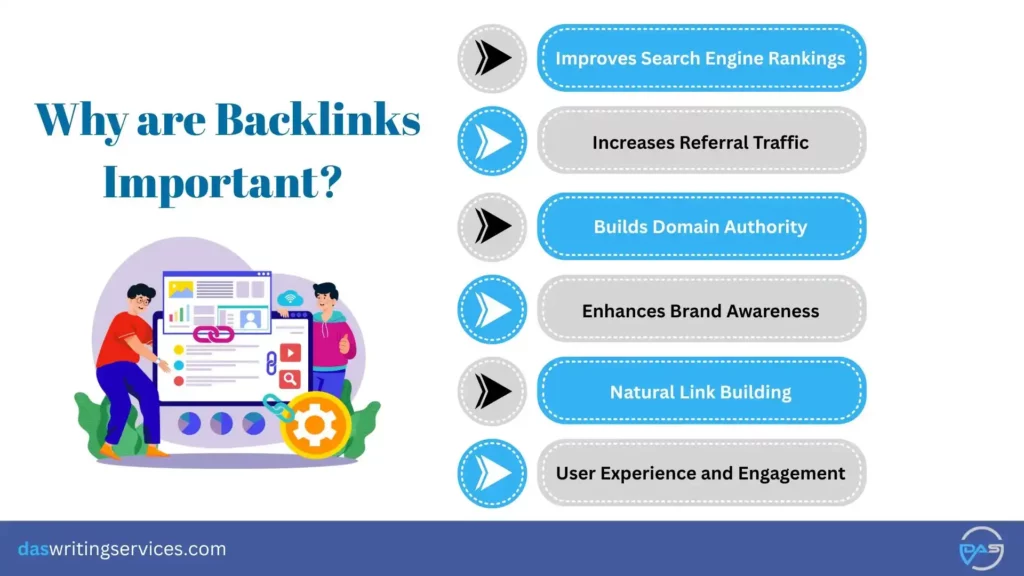Did you know that 91% of websites fail to attract organic traffic from Google, mainly due to a lack in link building efforts? Backlinks are pivotal in determining your website’s position on search engines and overall authority.
In 2025, building high-quality backlinks remains a cornerstone for improving your SEO performance. But how can you achieve this effectively?
This guide will walk you through 16 proven strategies on how to build backlinks and enhancing your online presence. Let us explore the methods that can help boost your rankings, drive traffic, and solidify your brand’s reputation in the digital landscape.
What are Backlinks?
Backlinks, or inbound external links are hyperlinks that direct users from a third party website to yours. For search engines like Google and Bing, backlinks serve as votes of confidence in the linking page/website, signalling that the content is authoritative, and worthy of a higher ranking.
Simply put, when other websites link to your pages for reference, it tells Google your content is valuable.
Today, backlink building strategies remain one of the most critical ranking factors in SEO. However, not all backlinks carry the same value, and the quality of your backlinks is just as important as the quantity.
Types of Backlinks: Do-Follow vs No-Follow
1. Do-Follow Backlinks
These are the most valuable types of backlinks for SEO purposes. Do-follow backlinks pass on link equity, also known as link juice, which directly impacts the search engine rankings of the linked website.
When a legitimate website with quality content links to your content with a do-follow tag, it signals to Google that your page is authoritative and helpful and deserves to rank higher in search results. The more high-quality do-follow backlinks you acquire, the more authoritative your site becomes.
2. No-Follow Backlinks
On the other hand, no-follow backlinks do not pass link equity to the linked website. A no follow tag tells search engine crawlers not to follow the link. Thus the target page’s authority is neither increased or decreased with no-follow links.
However, they can still be valuable in driving traffic and increasing visibility. No-follow links are often used in situations where the linking site does not want to endorse the target site, such as in user-generated content or sponsored posts.
While no-follow backlinks do not directly impact your SEO, they are more natural and get organically created as your website’s exposure to diverse users increase over time.
16 Effective Strategies to Build Effective and Quality Backlinks
Building quality backlinks requires a strategic approach. Creating value is a sure shot way to attract backlinks from other industry players. But it is easier said than done. So, here are 16 highly effective ways to get relevant backlinks and enhance your website’s authority:
1. Guest Posting

What:
Guest blogging for backlinks is a cornerstone of backlink-building strategies, allowing you to reach new audiences while establishing credibility in your niche. By writing high-quality, informative articles for reputable websites, you can secure a backlink to your own site within the content or author bio.
How:
Reach out to authoritative websites that accept guest contributions. Craft a personalised pitch showcasing how your content will benefit their audience. Ensure that your article provides real value, addressing relevant topics or challenges that resonate with their readership.
Tips:
- Always prioritise quality over quantity.
- Few backlinks from high-authority sites are more impactful than many links from lesser-known domains.
- Align your content with the host site’s tone and format for relevance.
2. Use Social Media
What:
While backlinks from social media are typically no-follow, they can still drive a significant amount of referral traffic and enhance your brand visibility. Social platforms are crucial for amplifying your content to a broader audience, and as your content gets shared, there’s a higher likelihood of earning organic backlinks.
How:
Share your blog posts, infographics, and other valuable content on social platforms like LinkedIn, Facebook, Twitter, and Instagram. Engage actively with your audience to encourage sharing, which could result in your content being picked up by bloggers, journalists, or industry influencers.
Tips:
- Tailor your content for each social platform.
- E.g. create visual content for Instagram and detailed thought leadership posts for LinkedIn.
- Use relevant hashtags and participate in conversations to boost visibility.
3. Trend Reports
What:
Publishing original research or trend reports positions you as an authority in your industry. Websites and influencers often link to these reports as they provide exclusive, data-driven insights that are valuable to their audience. This naturally leads to backlinks from high-authority domains.
How:
Conduct surveys, gather data, or compile market trends in your industry. Package your findings in a well-designed report that offers a unique perspective. Share the report with bloggers, journalists, and influencers, encouraging them to cite your research.
Tips:
- Make reports visually appealing with charts, graphs, and infographics.
- Promote through email marketing and social channels.
4. Find Broken Backlinks and Suggest Replacements

What:
Broken link building is a strategic way for how to create backlinks while helping other websites improve their user experience. By identifying broken links on high-authority sites, you can offer your content as a replacement, creating a win-win scenario.
How:
Use tools like Ahrefs, SEMrush, or Broken Link Checker to identify broken links on websites within your niche. Reach out to the webmaster, politely informing them of the broken link and suggesting your relevant content as a replacement. Highlight how your content can fill the gap and improve their user experience.
Tips:
- Personalise your outreach and focus on offering genuine helpful content.
- Target high-quality backlinks from relevant, authoritative sites in the industry.
5. Include Infographics
What:
Infographics are highly engaging and shareable, making them an excellent tool for earning backlinks. Visual content is easier to digest than long-form text, and websites frequently link to infographics that simplify complex information.
How:
Design infographics that present data, trends, or tutorials related to your industry. Ensure that they are visually compelling and provide meaningful insights. When sharing your infographic, include an embed code so that websites can easily display it while linking back to your site.
Tips:
- Promote your infographic on visual platforms like Pinterest and infographic directories.
- Send it directly to creators and bloggers, encouraging them to link to it as a reference.
6. Image Credit
If you regularly create original images, illustrations, or infographics, you can offer them to websites in exchange for an image credit backlink. This is a low-effort way to earn backlinks, as many websites need high-quality visuals to accompany their content.
How:
Upload your images to image-sharing platforms like Unsplash, Pexels, or Flickr, with a requirement for attribution. Reach out to blogs and websites in your niche, offering your visuals in exchange for a backlink credit in the image description.
Tips:
- Ensure that your images are relevant to your target industry and solve a visual need (e.g., stock photos, data visualisations).
- Use Google reverse image search to find websites using your images without attribution and request a backlink in return.
7. Share Your Content on Forums
What:
Forums and online communities offer opportunities to share your expertise while linking back to your content. By participating in industry-specific forums, you can understand how to build backlinks and drive traffic from a highly engaged audience.
How:
Join forums such as Quora, Reddit, or niche-specific discussion boards. Answer relevant questions with detailed, insightful responses, and include a backlink to your content when appropriate. Be sure that your link adds value to the discussion rather than appearing spammy.
Tips:
Build a reputation within these communities by consistently providing high-quality contributions. Avoid overly self-promotional posts, rather focus on helping others, and your backlinks will come across as natural and useful.
8. Target Resource Pages
What:
Resource pages are curated lists of useful links, tools, and articles that can drive significant traffic. These pages are often maintained by authoritative websites and are highly valuable for gaining backlinks.
How:
Identify resource pages within your industry by using search queries like “best resources for [your niche].” Reach out to the webmaster, explaining why your content would be a valuable addition to their resource list.
Tips:
Offer highly actionable or comprehensive content that fills a gap in their existing resources. Provide a compelling reason why adding your link will benefit their audience.
9. Build Your Brand
What:
A strong brand is more likely to attract natural backlinks from other sites that reference your products, services, or thought leadership. By building a solid online presence, you can create a flywheel effect where others link to your content without any outreach efforts.
How:
Focus on creating exceptional content that establishes your authority in your niche. Engage in PR activities, contribute to industry events, and collaborate with influencers to boost brand visibility.
Tips:
Brand-building is a long-term strategy, but it yields organic backlinks as more people recognise and trust your expertise. Maintain consistency across your website, social channels, and content efforts to solidify your brand’s identity.
10. Q&A Sites
What:
Q&A platforms like Quora and Stack Exchange offer a space to demonstrate your knowledge while earning backlinks. These platforms are visited by millions of users seeking answers to specific questions, making them prime opportunities for sharing your expertise and content.
How:
Provide thorough, insightful answers to questions related to your industry. When relevant, include a link to your blog post, case study, or article that expands on the topic. Ensure that your response genuinely helps the user rather than simply promoting your link.
Tips:
Be consistent in answering questions over time. The more helpful your answers, the more likely users are to follow your links for additional information, driving both traffic and backlinks.
11. Replicate Your Competitors’ SEO Backlinks Best Practises
What:
A smart way to identify how to build backlink opportunities is by analysing your competitors’ backlink profiles. By examining where your competitors are getting their links, you can target the same sources to secure similar backlinks for your own site.
How:
Use tools like Majestic, Moz, or SpyFU to identify the backlinks of your top competitors. Analyse the types of websites linking to them, and reach out to these sites with your own relevant content or collaboration proposals.
Tips:
Focus on acquiring backlinks from high-quality, authoritative domains that link to your competitors. Avoid low-quality or spammy sites, even if your competitors have backlinks from them.
12. Connect with Other Industry Experts
What:
Forming connections with other experts in your field can lead to collaboration opportunities such as guest posts, podcasts, or interviews. These collaborations often include backlinks to each other’s websites, benefiting both parties.
How:
Engage with industry leaders through social media, webinars, or networking events. Offer to collaborate on content projects, such as co-authoring blog posts, participating in interviews, or contributing to each other’s publications.
Tips:
Always approach collaboration with a win-win mindset. The goal is to create value for both audiences while building backlinks that enhance each site’s authority.
13. Release Data Studies
What:
Original research and data-driven content are highly valuable in the digital space. Websites, bloggers, and journalists often reference and link to studies or reports that provide unique insights or statistics.
How:
Conduct surveys, analyse data, or compile existing research to create a comprehensive study or report. Publish it on your website, and reach out to industry publications, influencers, and bloggers who may be interested in sharing or citing your findings.
Tips:
Make your report easy to reference by including visual aids like graphs, charts, and tables. Promote it across multiple channels to maximise visibility and backlink opportunities.
14. Product Reviews
What:
Product reviews from influencers, bloggers, and industry experts can significantly boost your backlink profile and drive traffic. When a reputable reviewer evaluates your product or service, they often include a backlink to your site in their review, enhancing both your credibility and SEO.
How:
Reach out to bloggers, industry experts, or influencers who review products in your niche. Offer them a sample of your product or a free trial of your service in exchange for an honest review. Ensure that the review is detailed and includes a backlink to your website or product page.
Tips:
Target reviewers who have a genuine interest in your industry and whose audience aligns with your target market. Craft a compelling pitch that highlights the unique aspects of your product and why it would be valuable to their readers. Follow up with reviewers to share the published review and thank them for their efforts.
15. Recover Lost Backlinks
What:
Recovering lost backlinks is a crucial aspect of maintaining a strong backlink profile. Over time, links can be lost due to website changes, content updates, or broken links. Addressing these issues promptly helps preserve your SEO value and ensures that you continue to benefit from these valuable links.
How:
Use SEO tools like Ahrefs, Moz, or SEMrush to monitor your backlink profile and identify lost links. Once you’ve pinpointed the lost backlinks, contact the webmasters of the sites that were previously linked to you. Politely explain the situation and request that they restore the link to your updated content or website.
Tips:
Maintain a record of your backlinks and any changes made to your site or content that may have affected them. Being proactive about monitoring and recovering lost backlinks helps prevent SEO drops and ensures that your backlink profile remains strong.
16. Paid Backlinks
What:
While buying backlinks is generally frowned upon by search engines, there are ethical ways to invest in link placements that comply with SEO guidelines. Paid backlinks can be effective when they come from reputable sites and are clearly disclosed as sponsored content.
How:
Identify high-quality websites that offer sponsored content or how to build backlinks opportunities. Ensure that any paid placements are marked as sponsored to adhere to Google’s guidelines. Create valuable content for these placements that provides real benefits to the site’s audience, ensuring that the investment is worthwhile.
Tips:
Choose reputable sites with a strong domain authority and a relevant audience. Avoid using paid backlinks as your primary strategy; instead, integrate them with other ethical link-building efforts. Transparency is crucial, as always disclosing sponsored content helps to maintain trust and credibility.
Why are Backlinks Important?

Backlinks are an essential component of SEO, and understanding their importance can help you craft a better strategy. Below are several reasons why backlinks are crucial:
1. Improves Search Engine Rankings
Building relevant backlinks from credible sources remains a key ranking factor in Google’s algorithm. High-quality backlinks from authoritative websites help search engines recognize your content as valuable, boosting your position in search results.
2. Increases Referral Traffic
Backlinks drive traffic from external sites to your website. When users click on a link pointing to your site, it increases the amount of referral traffic, expanding your reach.
3. Builds Domain Authority
Domain authority reflects how well your site is likely to rank on search engines. High-quality backlinks signal that your content is credible, which helps improve your domain authority over time.
4. Enhances Brand Awareness
When your site is referenced by other authoritative websites, it increases your brand’s visibility. Being linked by reputable sources not only boosts SEO but also enhances your brand’s reputation, making it more recognizable in your industry.
5. Natural Link Building
The more valuable and authoritative your content is, the more likely other sites will naturally link to it over time. This type of organic link-building is a strong signal to search engines that your site offers content worth recommending.
6. User Experience and Engagement
Backlinks can improve the user experience by directing visitors to relevant, valuable content on your site. High-quality content linked from other websites helps users find useful information, encouraging longer engagement and improving metrics like bounce rate and time on site.
Takeaway
How to build backlink in 2025 is essential for improving your website’s SEO and driving organic traffic. By implementing the 16 strategies outlined above, from guest posting and using social media to recovering lost backlinks and engaging in ethical paid placements, you can effectively enhance your site’s authority and visibility.
Stay committed to ethical practices and continuously refine your strategies based on industry trends and insights. With time and effort, your backlink profile will become a powerful asset in your overall SEO strategy, contributing to long-term online success.
Frequently Asked Questions
How to build backlinks come from authoritative sites within your industry, have relevant content, and ideally, are do-follow links. Assess the site’s domain authority, relevance to your content, and the link’s placement within the content.
Yes, guest posting remains a valuable strategy when done correctly. Focus on contributing to reputable sites with a relevant audience and providing high-quality content that adds value.
Share your content on social media platforms to increase its visibility and encourage sharing. Engaging actively with your audience can also lead to organic backlinks from users and influencers who find your content valuable.
Trend reports are comprehensive studies or surveys that provide unique insights or data on industry trends. They are highly shareable and can attract backlinks from websites and journalists interested in citing your original research.
Broken link building involves finding broken links on other websites and offering your content as a replacement. This approach helps improve the host site’s user experience while securing a valuable backlink for your site.
Subhodip Das is the founder and CEO of Das Writing Services Pvt. Ltd. He has an experience of 12 years in the field of Digital Marketing and specialises in Content Writing and Marketing Strategies. He has worked with well-established organisations and startups helping them achieve increased Search Engine Rank visibility. If you want to grow your business online, you can reach out to him here.






Leave a comment